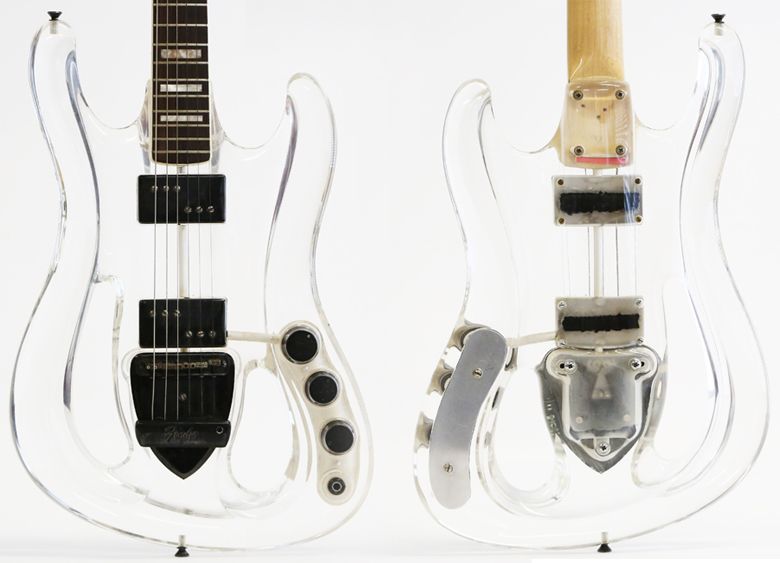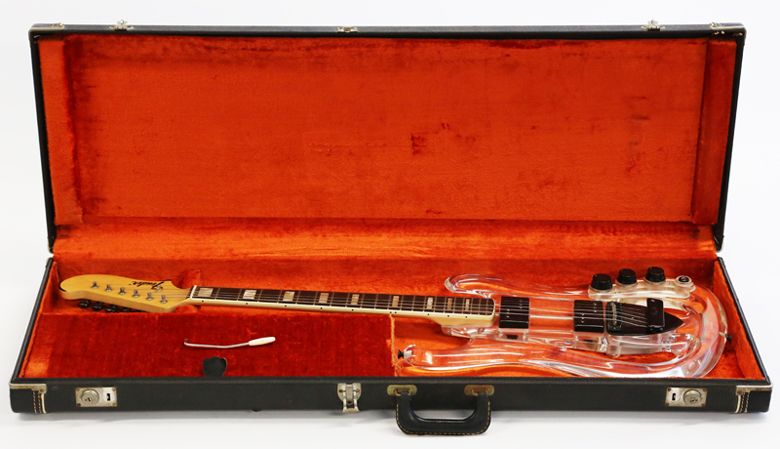Here's yet more proof that Fender have not always been stuck in a rut ("another Strat, another Tele" as Leo Fender himself once said). This very modern-looking sculpted lucite-bodied Fender guitar actually dates back to 1972, but it is a one-off creation by Roger Rossmeisl who as well as designing for Rickenbacker was the man who brought us the Fender Coronado, Starcaster, and the much more popular Telecaster Thinline.
Note that this prototype borrows the Starcaster neck as evidenced by its distinctive headstock. Note also how the body has been sculpted and features two through-body holes either side of the bridge; anyone who has ever picked up a luctite-bodied guitar should know how heavy they can be, so it looks like the sculpting and body holes were all part of a weight-reducing effort - which would suggest that the guitar was conceived to be lucite-bodied should have gone to the production, and not that merely the prototype was made that way.
I'm going to be really cheeky and heavily borrow text from the eBay listing, but this is the kind of information that needs to be preserved and recorded for prosperity as I feel this guitar is an important and very interesting part of the history of Fender guitars:
For your consideration is this vintage 1972 Fender prototype electric guitar. This one-of-a-kind creation was hand-designed by Roger Rossmeisl himself, who is well-regarded as a former Rickenbacker designer, and also father of the Fender: Telecaster Thinline, Starcaster, and Coronado. A very fine luthier in his own right, Rossmeissl was originally scouted by Leo Fender himself for the purposes of crafting Fender's line of acoustic guitars. An unbelievably talented pioneer with regard to guitar design, Roger Rossmeisl might not be as legendary as the likes of better known builders Leo Fender and Paul Bigsby, but his ever-lasting impact is arguably just a important. Having introduced his, originally his father's (Wenzel Rossmeisl), famous German-carve technique featured on numerous early Rickenbacker models, he is also credited with the development of the Rickenbacker 330 and 360, as well as, the Guild Starfire. His undeniable influence should be celebrated as his enduring vision transcended decades of development and remain just as timeless, relevant, and valuable today as ever. This breathtakingly unique model is special in nearly every way, and the historically significant provenance is just as incredible. This missing-link has long been discussed by enthusiasts, experts, and players alike after a photo of it being played by Carl Wilson of The Beach Boys surfaced many years ago.This guitar is currently listed on eBay with an unsurprising Buy It Now price of $29,999.99. Check the eBay listing for further photographs of this fascinating guitar.
This museum-piece is more than just a rare guitar, it is the only one of its kind. It signifies the attempt Fender considered to completely diverge from its previous path, toward an interesting and unknown direction. Much evidence exists of Fender experimenting with instruments, namely producing existing models with innovative features, and prototypes for successful models, but a Fender prototype for a model that was never released has not been documented.
Perhaps most important, is the utterly radical concept and futuristic space-age approach for the clear, contoured Lucite, body design, which was only to be enhanced by the special production black anodized parts, and correspondingly prototypical never-before-seen hardware. As previously suggested, all features and details of this guitar are unique and extreme, having required immense effort, complete hand-tooling, and significant hands-on attention from Rossmeissl himself. Yes, the Seth Lover designed Wide Range Humbucking Pickups sport black anodized covers, and even the otherwise standard Fender "F" tuning machines have black anodized buttons. The body has stylized cut-outs to reduce weight, which seems most logical, yet they simultaneously contribute to the overall sculptural essence of the body. The highly carved and beautifully refined layers and shapes required the eye and hand that only an artist like Rossmeisl possessed.
Since the guitar was photographed sometime in early-mid '72 being played by Carl Wilson alongside other members of the Beach Boys while recording their '73 album Holland, it can only be deduced that this prototype guitar was finished sometime in late-'71 to early'72. It features a Marauder prototype headstock Fender model to feature the Starcaster headstock profile, as well as, one of the first to be equipped with the incredible Seth Lover-designed W.R.H.P.s. Nevermind the hardware which has never been seen on any other known model.
The Carl Wilson connection is interesting, as the Beach Boys relationship with Fender was the best of any artist relations dynamic Fender had with any band. The Beach Boys exclusively used all Fender equipment since the beginning, as they were endorsed, and were usually exposed to custom color versions, special order instruments, and even rarer low-production examples. In fact, the Fender promotional photo where Carl Wilson can be seen playing this guitar, features several prototype Fenders within, including a prototype Coronado being played by Blondie Chaplin.
This instrument was not just a promotional tool, not simply placed in the hands of Carl for a quick Fender photo shoot, and not only to be used in a featured catalog of some sort, as it would not return to Fender's Fullerton factory because it would stay with Carl for many years to come. Though we do not have access to additional photos of him using the guitar, he owned it for many years to come.
Whether this guitar was intended to compete with Dan Armstrong lucite guitars, be a one-of-a-kind prototype for late production models made of wood, or just be a special project, little is known about what some have called "The Mod." It is not just an amazing guitar, but is clearly a massive statement, and meaningful work of art. Mid-Century Modernists will appreciate its contours just as much as a collector would, and it could equally be considered an important Fender prototype as it could an advanced architectural enigma.
Very few opportunities are impossible to recreate, but this offering might only be made once, so do not hesitate and make an offer, as the next owner of this guitar will most likely discover its ultimate importance, only enhancing its value over time.
The guitar includes the original case and the original mini-trem arm. It is in all original, unmodified condition, and has only a small 2/5" pressure crack near the neck joint. It is otherwise in very excellent all original shape.
Thanks to Rick Smith for bringing this guitar to my attention.
G L Wilson
© 2012, Guitarz - The Original Guitar Blog - now in its 10th year!





Magnificent! this guitar could have changed guitar making history!
ReplyDeleteAt the time, I suppose I thought it would! While I truly appreciate the design and after seeing Keith playing a Dan Armstrong for the first time, many of just assumed this was the future of the electric guitar. It made sense on so many levels.
DeleteAnd while I acknowledge the true significance of what can only be described as a "barn find", in the end, the Beach Boys were a -vocal- group! Inclusive of the Wrecking Crew themselves ( and Blondie hasn't changed a bit ) members of the Ventures, Glen Campbell and many other guitar greats sitting in, they were still largely a vocal-driven group. So this may be a must have for Fender fanatics but it's contribution to R & R and even the Beach Boys themselves appears to be minimal. To wit, only (1) known photograph of it appears to exist, thankfully for the seller.
Color Combination is the most important thing. I think use of light colors for blog is the best practice. deep colors don’t look professional.
ReplyDeletePCB Design